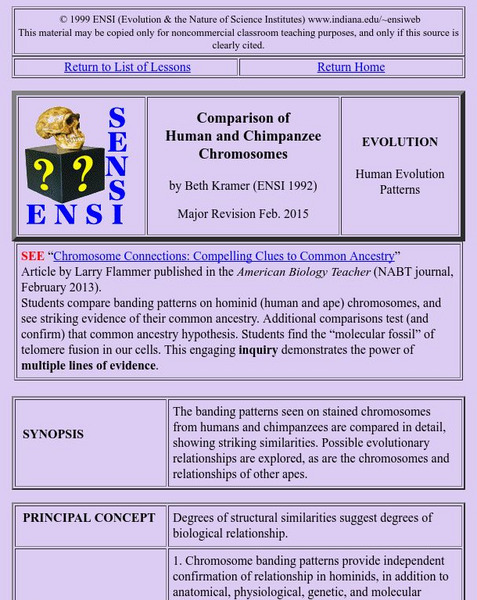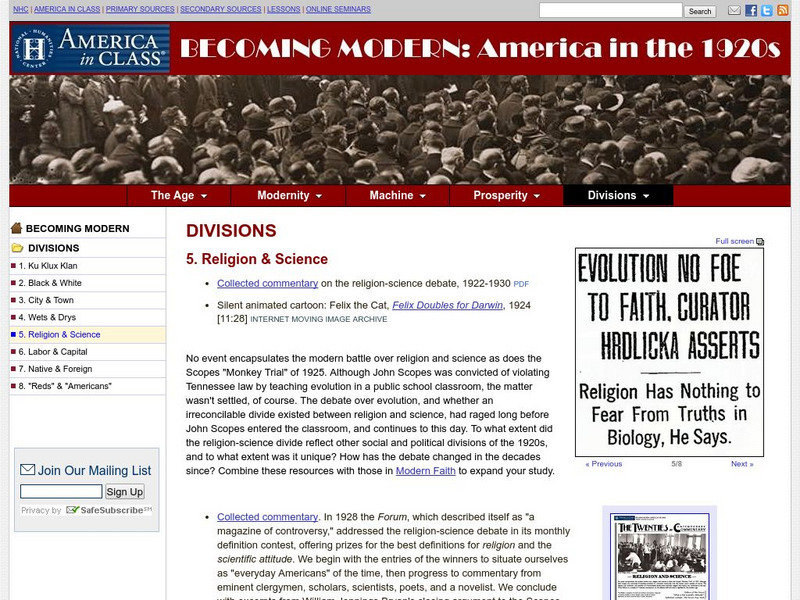Curated OER
Inspired Science
Students explore the history of inventions and their difference from discoveries. They create timelines of inventions, demonstrating their connections to each other.
Curated OER
The Right Tool for the Job: Fishing Tools and Technology
Students use modern technology to research the history, design, and function of a specific tool or piece of fishing technology. They create a timeline and story about the evolution of the tool.
Curated OER
Mother Nature's Laboratory
Students research how various plants and animals adapt over time to specific habitats and for specific purposes. Students produce a pictorial report on an example of an animal or plant's adaptation.
Curated OER
13 Ways to Tell Time Backwards
Learners explore different ways geological time can be measured: comparing the time dimensions for each method, the mechanisms of each method, and the materials used.
Curated OER
Why Don't Whales Have Legs?
Students are given a variety of materials and are asked to design a heat loss experiment that results in a reasonable explanation of "Why don't whales have legs?" students work with the theory of natural selection.
Concord Consortium
Concord Consortium: Stem Resources: Changes in the Environment
An activity to help students understand that as the environment changes, plants and animals must evolve to stay alive. Students watch as a mystery plants grow in a changing environment to see if they will evolve or go extinct.
Concord Consortium
Concord Consortium: Stem Resources: Confliction Selection Pressures
Investigate how selection pressures and natural selection influence populations growth with this computer model. Understand how a population changes when selection pressures are in conflict. Perform the virtual lab to see what happens to...
Concord Consortium
Concord Consortium: Stem Resources: Natural Selection
Build a dam in the middle of an ecosystem and observe how the population of plants and animals adapt to their new environment with this science simulation. Learn how the populations adapt to survive in their new habitat. Then remove the...
American Museum of Natural History
American Museum of Natural History: Darwin Digital Library of Evolution
This American Museum of Natural History project is a valuable resource for anyone with an interest in studying evolution. They have created a digital library of Darwin's notes, publications, and manuscripts. The information is presented...
California State University
Urbanowicz on Darwin: The Life & Death of Charles Darwin
This resource provides a paper written by Dr. Charles Urbanowicz, anthropologist at California State University. It deals extensively with the life and death of Charles Darwin, his research, and the publication of his book, "The Origin...
George Mason University
Chnm: Between the Wars: The Scopes Trial
Read the fascinating transcript of the proceedings in court when Clarence Darrow called William Jennings Bryan to the stand to expose the weakness in his argument against evolution in the famous Scopes trial.
Indiana University
Ensi: Comparison of Human: Chimpanzee Chromosomes Lesson
This is a great lesson plan that combines Karoytypes and evolution. Students will recognize that the chromosomes of chimpanzees and humans are remarkably similar, then correlate that to their evolutionary relationship.
Massachusetts Institute of Technology
Mit: Open Course Ware: Courses: Biology: Introductory Biology
College-level introductory biology course focusing on the application of the fundamental principles of human biology. Course topics include genetics, cell biology, molecular biology, disease (infectious agents, inherited diseases and...
Burke Museum
Burke Museum: Archaeology
The archaeology research and collection section of the Burke Museum provides great information. The section is divided into three headings including research, collections, and people.
National Humanities Center
National Humanities Center: America in Class: America in the 1920s: Religion & Science
The National Humanities Center presents collections of primary resources compatible with the Common Core State Standards - historical documents, literary texts, and works of art - thematically organized with notes and discussion...
Georgia Department of Education
Ga Virtual Learning: Ecosystems
This module offers an in depth study of the fundamental components of ecosystems. Activities include mini-lessons with videos and student assignments.
Georgia Department of Education
Ga Virtual Learning: Ap Biology: Welcome
This online course includes the exploration of several subjects in biology through field study and labs at an advanced level to deepen the students' understanding of biology.
TED Talks
Ted: Ted Ed: How Did Feathers Evolve?
To look at the evolution of modern bird feathers, we must start a long time ago, with the dinosaurs from whence they came. Carl Zimmer explores the stages of evolution and how even the reasons for feathers have evolved over millions of...
PBS
Pbs Learning Media: Tetrapod Limbs
This illustration from Evolution by Monroe W. Strickberger shows the remarkable similarities between the bones in the forelimbs of various tetrapods, all of whose limbs serve very different functions.
PBS
Pbs Learning Media: Shape of Trees: The Frustration Principle
This series of images shows the work of biologist Karl Niklas on the adaptations and evolution of plants. From The Evolutionary Biology of Plants.
PBS
Pbs Learning Media: Mammals Get Their Chance
In this video segment adapted from NOVA, animations of an asteroid hitting Earth are used to illustrate this widely accepted theory of dinosaur extinction and the resulting conditions that favored mammals.
PBS
Pbs Learning Media: Chris Schneider: Rethinking Conservation
In this interview filmed for Evolution: "Darwin's Dangerous Idea," biologist Chris Schneider discusses the relationship between conservation and speciation.
PBS
Pbs Learning Media: Allopatric Speciation
These images from the Smithsonian Institution depict Nancy Knowlton's work with snapping shrimp in Panama. Knowlton found that the closing of the isthmus -- dividing the Pacific Ocean from the Caribbean -- resulted in new species of shrimp.
PBS
Pbs Learning Media: Darwin's Letters: Collecting Evidence
This group of letters is a sample of the extensive correspondence Darwin carried on with a wide group of friends and colleagues as he collected evidence to support his theory of evolution by natural selection. From Charles Darwin's...

















